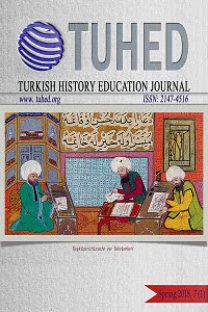Çeviri: Tarih
J.F. Herbart, yaptığı çalışmalarla Alman ruhunu kıtalar ötesine taşıyarak eğitim bilimleri, öğretim yöntemleri, sosyal psikoloji, öğretmen yetiştirme gibi alanlarda 20. yüzyılın ilk çeyreğine kadar ABD dâhil birçok ülkede fikirleri önemli derecede etkili olmuş bir filozoftur. Tarih eğitimi üzerine yazdıkları 19. yüzyıl başlarında Almanya’daki öğretmenlerin yaklaşımlarını ve Herbart’ın kendi görüşlerini ifade etmektedir. ABD’li Herbartçı Charles De Garmo’nun yorumları ise Alman ve Amerikan tarih öğretimi arasındaki farklılıkları, Alman eğitimindeki yaklaşımların Amerikan eğitimindeki karşılıklarını, sözlü ve yazılı yöntemlerin farklı yönlerini aktararak iki farklı tarih öğretimi yaklaşımını önermektedir. Bu yazının Johann Friedrich Herbart’a ait olan orijinal metni, Herbart’ın 1835 yılında yayımlanan “Umriß pädagogischer Vorlesungen” (Pedagoji Ders Notları) isimli eserinin, farklı branşların öğretimi üzerine yazdığı bölümünde tarih öğretimiyle ilgili kısmını içermektedir. Almancadan Türkçeye yapılan çevirinin bu kısmı için Kehrbach’ın tıpkıbasımı esas alınmıştır. Bu basımdaki numaralandırma takip edilerek Herbart’ın metninde paragraf sonlarına eklenmiştir. Sunulan çeviriye ek olarak alt metinlerde italik olarak verilen paragraflar ise bu eserin 1904 yılında “Outlines of Educational Doctrine” ismiyle Alexis F. Lange tarafından yapılan İngilizce çevirisine ABD’li Herbartçı Charles De Garmo’nun tarih öğretimiyle ilgili kısma eklediği yorumlarının çevirisidir. Bu bakımdan Herbart’ın kendi yazdıkları Almanca orijinalinden ve De Garmo’nun yorumları da İngilizce metin üzerinden çevrilmiştir.
Anahtar Kelimeler:
tarih öğretimi, Alman tarih öğretimi, Amerikan tarih öğretimi, tarih dersi, Charles De Garmo, Johann Friedrich Herbart
Translation: History (Geschichte)
J.F. Herbart is a philosopher whose ideas were very influential in many countries, including the USA, until the first quarter of the 20th century, in fields such as educational sciences, teaching methods, social psychology, teacher training, and he transferred the German spirit beyond the continents with his works on education. His writings on history teaching present the approaches of German teachers in the early 19th century as well as his own opinions. In the comments of the leading American Herbartian Charles De Garmo, the differences between German and American history teaching, the equivalents of the approaches in German education in American education, and the differences between the narrative and textbook method of teaching were described. It proposes two different approaches to history teaching by introducing different aspects of these methods. De Garmo was awarded his doctorate from the Herbartians in Germany. As the first president of the "National Herbart Society for the Scientific Study of Education", organized in 1895 "to study and investigate and discuss important problems of education", he pioneered the dissemination of Herbart's ideas in the USA. The original text of this article, which belongs to Johann Friedrich Herbart, includes the part about history teaching of his famous book "Umriß pädagogischer Vorlesungen", published in 1835, on the teaching of different branches. Kehrbach's facsimile was taken as the basis for this part of the translation from German to Turkish. In Herbart's text, the numbering in this edition is followed and added at the end of the paragraphs. The paragraphs given in italics in the sub-texts in addition to the translation presented are the translations of De Garmo’s comments added to the English translation of this Herbart’s book in 1904 under the name "Outlines of Educational Doctrine" by Alexis F. Lange. In this respect, Herbart's own writings were translated from the German original version and De Garmo's comments were translated from his English script.
Keywords:
history teaching, German history teaching, American history teaching, Johann Friedrich Herbart, Charles De Garmo, course in history,
___
- Ata, B. (2009). Johann Friedrich Herbart'ın Tarih Eğitimi Üzerine Görüşleri. Gazi Üniversitesi Gazi Eğitim Fakültesi Dergisi, 29, 1377-1395.
- Butts, R. F. ve Cremin, L. A. (1956). A history of education in American culture. New York: Henry Holt and Company.
- Chambliss, J. J. (1996). Herbart, Johann Friedrich. In J. J. Chambliss (Ed.), Philosophy of education: An encyclopedia (ss. 258-260). New York & London: Garland.
- Graves, F. P. (1912). Great educators of three centuries: Their work and its influence on modern education. New York: The Macmillan Company.
- Herbart, J. F. (1843). Kleine pädagogische Schriften (Vol. 3). Leipzig: F. A. Brockhaus.
- Herbart, J. F. (1887). Sämtliche Werke in chronologischer Reihenfolge. Hrsg. von Kehrbach, O. Flügel und T. Fritsch Band 1. Langensalza: Beyer & Mann.
- Herbart, J. F. (1891). Sämtliche Werke in chronologischer Reihenfolge. Hrsg. von Kehrbach, O. Flügel und T. Fritsch Band 4. Langensalza: Beyer & Mann.
- Herbart, J. F. (1898). Letters and lectures on education. (E. Felkin, Çev.). Swan Sonnenschein & Company.
- Herbart, J. F. (1902). The science of education and the asthetic revelation of the world (H. Felkin, E. Felkin, Çev.). Boston: DC Heath & Company.
- Herbart, J. F. (1904). Outlines of educational doctrine. (A. F. Lange, Çev.). New York: Macmillan.
- Herbart, J. F. (1912). Sämtliche Werke in chronologischer Reihenfolge. Hrsg. von Kehrbach, O. Flügel und T. Fritsch Band 10. Langensalza: Beyer & Mann.
- Herbart, J. F. (1959). Allgemeine Pädagogik aus dem Zweck der Erziehung abgeleitet Weinheim: Julius Beltz.
- Herbart, J. F. (1984). Umriss pädagogischer Vorlesungen. Padeborn: Ferdinan Schöningh.
- Nohl, H. (1958). Der lebendige Herbart. Erziehergestalten (ss. 51-59). Göttingen: Vandenhoeck & Ruprecht.
- Rein, W. (1905). Enzyklopädisches Handbuch der Pädagogik. Langensalza: Hermann Beyer&Söhne (Beyer & Mann).
- Rosenberg, D. ve Grafton, A. (2010). Cartographies of Time: A History of the Timeline. New York: Princeton Architectural Press.
- Sağdıç, Ö. Ş. (2019). Johann Friedrich Herbart’ın Eğitim Felsefesi. (Yayımlanmamış Yüksek Lisans Tezi), Ankara Üniversitesi Eğitim Bilimleri Enstitüsü, Ankara.
- ISSN: 2147-4516
- Yayın Aralığı: Yılda 2 Sayı
- Başlangıç: 2012
- Yayıncı: Ahmet Şimşek
Sayıdaki Diğer Makaleler
Satı BEY, Çevirmen: İbrahim Caner TÜRK
Çeviri: Akademi'nin kalbi: Orta Çağ üniversiteleri, ders kitapları ve akademik kütüphanelerin doğuşu
Christopher L. PROCTOR, Çevirmen: Berna ÜNAL
Osmanlı’da taşra darülmuallimin-i sıbyanların kuruluşu: Adana Darülmuallimin-i Sıbyan (1892-1908)
Johann Friedrich HERBART, Charles DE GARMO, Çevirmen: Özgün Şerif SAĞDIÇ
Çeviri: Akademi'nin kalbi: Orta Çağ üniversiteleri, ders kitapları ve akademik kütüphanelerin doğuşu
